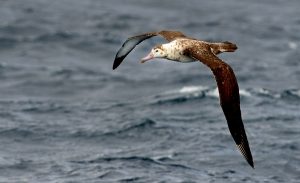Conservation of Amsterdam Albatrosses
By Samantha Owen, RJD Intern
This paper outlines the current conservation efforts for the Critically Endangered Amsterdam albatross (Diomedea amsterdamensis) and the threat posed by industrial longline fisheries. In 2007 a population survey estimated that there were only 167 Amsterdam albatrosses in the world. This is largely because they are only found in one place, Amsterdam Island, in the southern Indian Ocean. Their population declined dramatically in the 1960s and 1970s due to the increase in industrial longline fishing targeting bluefin tuna. While diving below the surface of the water when feeding, birds can be accidentally hooked or entangled in the longlines.
Like most albatrosses, this species is a biennial breeder, which means they only breed every other year. In between breeding years, they spend the entire break year roaming at sea. A successfully mated pair will produce only one egg per breeding year. This means that with such a small population, any mortality could have a huge impact on the viability of this species. The established threshold to trigger a population decline is a loss of more than six individuals to bycatch per year. The potential number of individuals removed from the Amsterdam albatross population each year due to longline fishing is 2-16 depending on whether mitigation measures such as tori lines, plastic streamers trailing from the back of the boat used to scare birds away, were systematically employed.
This paper quantifies the potential threat from industrial longline fishing fleets to the Amsterdam albatross based on time of year and life stages. It shows that even though the Amsterdam albatross is potentially in contact with longline fisheries at every stage of its life, non-breeding individuals have a much higher susceptibility due to their significantly increased roaming area during their break year at sea. The time of year when Amsterdam albatrosses are at the highest risk for mortality as a result of bycatch in longlines is the austral winter (July, August, September) when fishing fleets are targeting albacore and other tunas.
The Taiwanese longline fishing fleet poses the greatest threat to Amsterdam albatrosses, followed closely by the Japanese fleet. One reason it is thought that the Taiwanese fleet has such a high impact on the Amsterdam albatross is because they deploy the most longlines in the waters immediately adjacent to the species’ home, Amsterdam Island.
In conclusion, this paper states three recommendations for further conservation efforts. First, increasing the coverage of fishing operations by dedicated observers in the distribution range of the Amsterdam albatross during the austral winter. This would ensure the successful implementation of bycatch mitigation measures such as tori lines. The second recommendation is for Regional Fisheries Management Organizations (RFMOs) such as the Indian Ocean Tuna Commission (IOTC) to require all operating vessels to report ring recoveries. All Amsterdam albatrosses have been fitted with leg bands (rings) identifying each individual. Although it would not directly prevent bycatch, reporting all recovered rings would allow scientists to more accurately define population-specific bycatch patterns in regional areas resulting in more targeted conservation efforts. The third recommendation is to implement regulations on fishing efforts in the waters surrounding Amsterdam Island during the austral winter. The combination of these three conservation efforts would allow the world’s only population of the Amsterdam albatross to grow and prevent any further decline that might very well result in the extinction of the species.
References:
Thiebot J.B., Delord K., Barbraud C.B., Marteau C., Wemerskirch H. 2015. 167 individuals versus millions of hooks: bycatch mitigation in longline fisheries underlies conservation of Amsterdam albatrosses. Aquatic Conservation: Marine and Freshwater Ecosystems. DOI: 10.1002/aqu.2578



